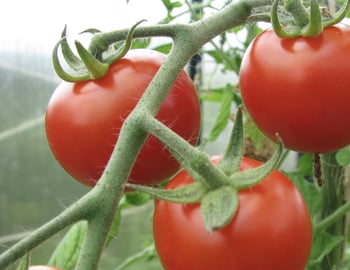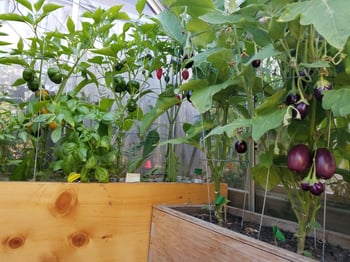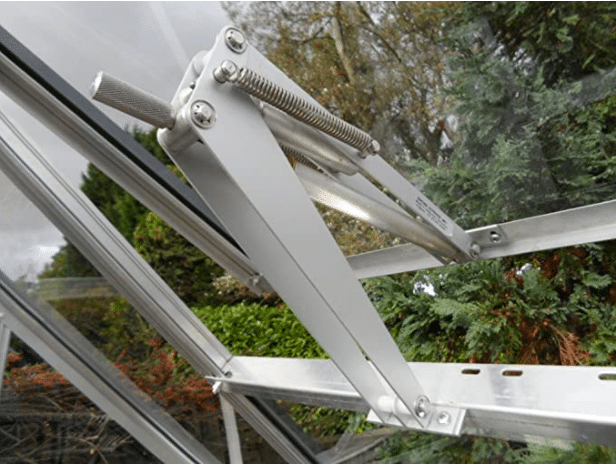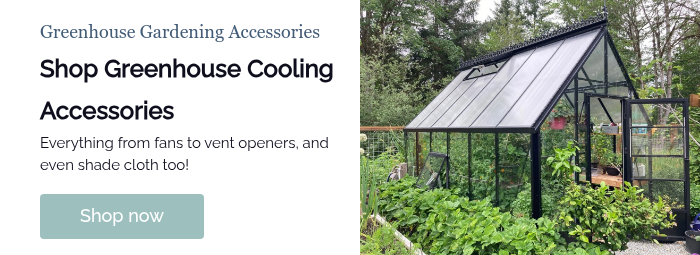Quick Answer:
To keep your greenhouse cool in summer, open vents early, run fans, and install shade cloth to manage heat. Water deeply in the morning with drip irrigation to retain moisture. Choose heat-loving crops like tomatoes and peppers, and consider smart tools like automatic vent openers and soil moisture sensors for consistent care. Read more below!
- Quick Answer
- Why Do Greenhouses Struggle in the Summer?
- How Do I Keep My Greenhouse Cool in Extreme Heat?
- How Should I Water My Plants in Hot Weather?
- What Are the Best Crops to Grow in the Summer?
- Can Tech Help Me Manage My Greenhouse in the Summer?
- What Maintenance Should I Prioritize This Season?
- What If I Live in a Storm-Prone Area?
- Want More Summer Greenhouse Tips?
Summer can be both a rewarding and stressful season for greenhouse growers. On one hand, you're working with the longest days of the year. On the other, you're up against sweltering temperatures and unpredictable storms. But with a few smart tweaks and a bit of planning, your greenhouse can thrive all summer long.
Here's how to get ready for whatever the season has in store.
Why Do Greenhouses Struggle in the Summer?
Greenhouses are designed to trap heat, which is great, until it's not. In the middle of a heatwave, temperatures inside your greenhouse can climb fast, putting your plants under major stress. Combined that with rising humidity and the risk of sudden storms, and summer can quickly turn into a challenge.
If you've ever opened your greenhouse door and been hit with a wall of heat, you already know the stakes. Luckily, you can take simple steps to stay ahead of the forecast.
How Do I Keep My Greenhouse Cool in Extreme Heat?
There isn't just one way to beat the heat in your greenhouse. Cooling it effectively requires a mix of smart airflow, shading, and sometimes a little help from technology. Here's a breakdown of the most effective strategies:
Open Vents and Doors Daily
It might seem simple, but regularly opening vents and doors is one of the easiest ways to flush out trapped heat. Aim to do this early in the day before things really warm up.
Add Exhaust Fans or Louvered Vents
Mechanical ventilation helps move hot air out and bring cooler air in, especially during windless or extremely hot days. Make sure your intake and outflow are balanced to maximize airflow.
Use Shade Cloth or Reflective Paint
Blocking excess sunlight can significantly reduce internal temperatures. Shade cloth is easy to install and can be customized for your structure. Reflective paint is another option that helps bounce light away before it becomes heat.
Try a Misting System or Evaporative Cooling
These systems can lower air temperatures through evaporation and are particularly helpful in dry climates. Misting also adds humidity, which can benefit some crops but should be balanced to avoid mold or mildew.
Even making just one or two of these changes can help you maintain a healthier, more stable growing environment through the hottest months.
How Should I Water My Plants in Hot Weather?
Hot weather means faster evaporation and thirstier plants. The key is to water deeply and consistently:
- Water early in the morning so moisture can be absorbed before the heat sets in.
- Use drip irrigation to deliver water directly to the roots.
- Mulch container plants and raised beds to lock in moisture.
At the same time, keep an eye on humidity. Overwatering or poor air circulation can invite mildew and mold. A hygrometer can help you track levels and make quick adjustments.
What Are the Best Crops to Grow in the Summer?
Summer is the season to grow crops that truly thrive in heat. Many warm-weather vegetables not only tolerate high temperatures, but actually perform better with consistent warmth and long daylight hours. These include:

Tomatoes
A greenhouse favorite, tomatoes love the heat but still benefit from regular airflow and consistent watering.
.jpg?width=350&name=unnamed%20(7).jpg)
Peppers
Whether sweet or spice, peppers flourish in the warmth and are well-suited to raised beds or containers.

Eggplant
Another sun lover that performs best with even temperatures can protection from cool nighttime dips.

Melons
These vines need space, warmth, and time. Greenhouses give them the heat they crave and help extend your growing season.
If you're planning to grow herbs or leafy greens like lettuce, spinach, or cilantro, position them in cooler corners of the greenhouse or use shade cloth to prevent bolting. You can also stagger planting times or grow these more sensitive crops during the shoulder seasons when temperatures are milder.
Can Automation Help Me Manage My Greenhouse in the Summer?
Technology can be a powerful ally when managing your greenhouse in hot weather. From automated systems to simple digital tools, here are a few options that can lighten your workload and protect your plants:
- Thermometers and hygrometers: Knowing your greenhouse temperature and humidity levels in real time is the first step in making informed adjustments. Digital models are easy to read and can alert you when conditions move out of range.
- Automatic vent openers: These clever tools work without electricity, using wax-filled cylinders that expand and contract with the temperature to open and close vents. All BC Greenhouses include these types of vent openers standard with each order. It's a set-it-and-forget-it option for natural ventilation.
- Smart irrigation systems: Connected watering systems can be scheduled or controlled remotely via an app, making it easy to maintain consistent moisture levels even when you're not home.
- Soil moisture sensors: These sensors monitor the water level at the root zone, helping you avoid both underwatering and overwatering; which are two common stressors during summer heat.

Using one or two of these tools can make greenhouse growing easier and more efficient. During heatwaves or weekend trips away, having a smart system in place can provide peace of mind while keeping your plants healthy.
What Maintenance Should I Prioritize This Season in my Greenhouse?
Summer maintenance isn't just about keeping things clean, it's about making sure every part of your greenhouse is ready to handle heat, storms, and heavy use. A little attention now can prevent bigger issues later.
- Clean vents, filters, and fan blades: Dust, pollen, and plant debris can build up fast in the summer. Clean your vents and fans regularly to keep airflow consistent and reduce strain on electrical components.
- Inspect door seals and glazing for wear: As temperatures rise, materials expand and contract. Check for any gaps or loose seals around doors, windows and panels. Tight seals help you maintain control over internal temperature and humidity.
- Test your irrigation and misting systems: Summer is not the time for water system surprises. Run your systems to check for clogs, leaks, or uneven pressure. Confirm timers are working and set to water at optimal times.
- Clear away debris that could block airflow or drainage: Dead leaves, weeds, or clutter can block vents and create standing water. Sweep walkways, empty trays, and check your gutters and downspouts to prevent backup during storms.
Make these checks part of your weekly routine. A few minutes of upkeep can go a long way in avoiding plant stress, equipment failure, or emergency repairs when the heat is at its peak.
What If I Live in a Storm-Prone Area? How do I prepare my my Greenhouse For A Summer Storm?
If summer storms are a regular part of your forecast, a few proactive steps can help protect your greenhouse and the plants inside:
- Secure roof and side vents: In storm-prone areas, it's important to ensure that all roof and side vents are properly latched or locked to prevent them from being forced open by high winds. Double-check that auto-vent openers are disengaged or secured if severe weather is expected. This helps maintain the integrity of your structure and reduce the risk of damage during sudden gusts.
- Ensure your greenhouse is properly installed on a foundation: All BC Greenhouses are designed to be installed on a secure, level foundation such as a concrete pad, concrete footing, or pressure-treated wood base. A properly built foundation helps your greenhouse maintain its structural integrity and ensures it performs as intended during high winds or severe weather events.
- Create a plant evacuation plan: Identify your most vulnerable crops, such as tender seedlings or potted tropicals, and make a plan to temporarily relocate them indoors or to the sheltered area if severe weather is forecasted.
- Review your greenhouse warranty and take photos: BC Greenhouse Builders offers a lifetime warranty on the frame and a limited lifetime warranty on the glazing of your greenhouse. Two features that reflect the long-term durability of our structures. Even with these protections in place, we recommend documenting the condition of your greenhouse at the start of each season. This step can help streamline warranty or insurance claims should the unexpected occur and give you peace of mind knowing you're prepared.
Taking the time to prepare in advance can go a long way in minimizing damage and downtime during the summer storm season.
Want More Summer Greenhouse Tips?
We've got you covered. Whether you're looking for weatherproofing advice or crop recommendations our team is here to help:
With the right prep, your greenhouse will be ready for a strong, stress-free summer season.
Want Help Finding Your Perfect Greenhouse Fit
Contact our team of greenhouse experts for a consultation to match your climate, growing style, and garden goals








